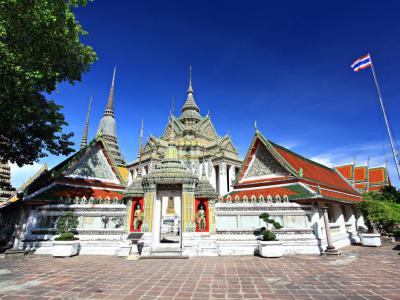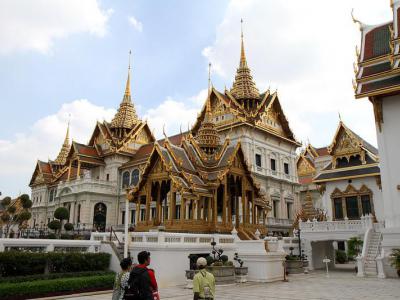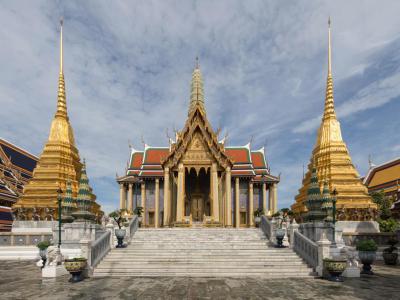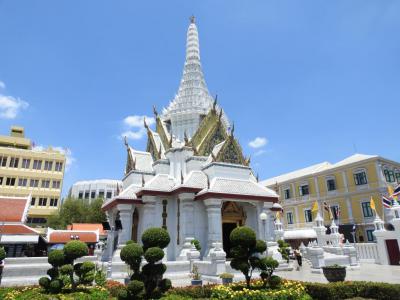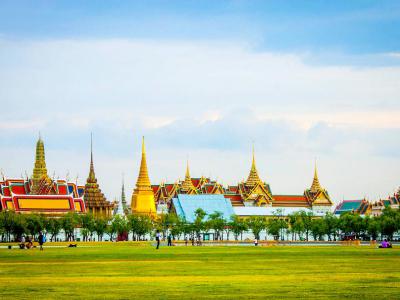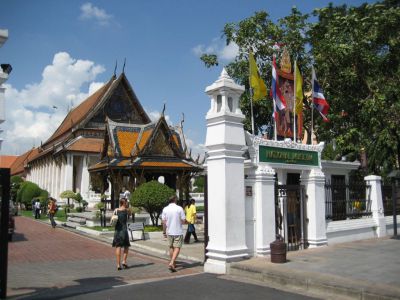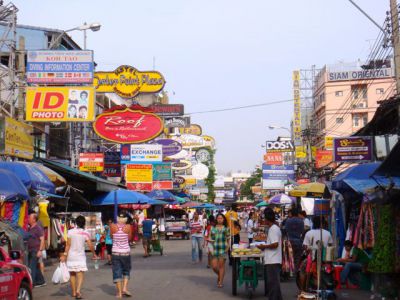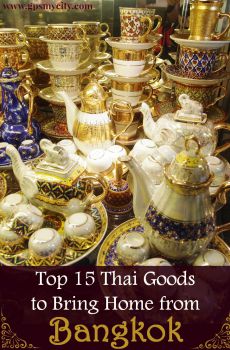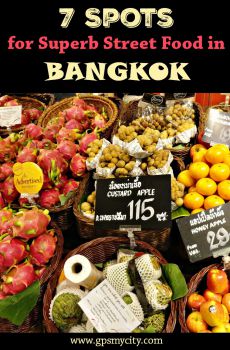Bangkok Old City Walk (Self Guided), Bangkok
The Thai capital Bangkok emerged in the 15th century as a small trading post in the Chao Phraya River delta. The origin of the name “Bangkok” is unclear and was likely a colloquial adopted by foreigners, in which Bang is the Thai word for “village on a stream” and Ko means “island”, referring to the city's watery landscape. Another opinion is that it may be shortened from Bang Makok, with Makok being the name of a local olive-like fruit.
Officially known as Krung Thep Maha Nakhon or simply Krung Thep, the city also bears a ceremonial name which consists of 168 letters and comprises Pali and Sanskrit words translating as “City of angels, great city of immortals, magnificent city of the nine gems, seat of the king, city of royal palaces, home of gods incarnate, erected by Vishvakarman at Indra's behest” – the Guinness World Record for the longest name of a geographical location.
In the course of history, Bangkok has seen many events, including the modernization of Siam, renamed Thailand in the late-19th century, numerous coups and uprisings, followed by rapid growth of the 1960s-1980s and the investment boom of the 1980s-1990s. Nowadays, a regional force in finance and business, as well as a center for arts, fashion and entertainment, the city is known for its street life and cultural landmarks.
Situated just north of Bangkok's Chinatown, the Old City (Rattanakosin) houses a glittering array of spectacular and revered temples, historic palaces and ancient architecture. Important highlights in Bangkok Old Town include the regal Grand Palace, the awe-inspiring beauty of Wat Phra Kaew, as well as the traditional learning center Wat Pho. To explore these and other top tourist sights in Bangkok's Old City, follow this guide to kick off your trip!
Officially known as Krung Thep Maha Nakhon or simply Krung Thep, the city also bears a ceremonial name which consists of 168 letters and comprises Pali and Sanskrit words translating as “City of angels, great city of immortals, magnificent city of the nine gems, seat of the king, city of royal palaces, home of gods incarnate, erected by Vishvakarman at Indra's behest” – the Guinness World Record for the longest name of a geographical location.
In the course of history, Bangkok has seen many events, including the modernization of Siam, renamed Thailand in the late-19th century, numerous coups and uprisings, followed by rapid growth of the 1960s-1980s and the investment boom of the 1980s-1990s. Nowadays, a regional force in finance and business, as well as a center for arts, fashion and entertainment, the city is known for its street life and cultural landmarks.
Situated just north of Bangkok's Chinatown, the Old City (Rattanakosin) houses a glittering array of spectacular and revered temples, historic palaces and ancient architecture. Important highlights in Bangkok Old Town include the regal Grand Palace, the awe-inspiring beauty of Wat Phra Kaew, as well as the traditional learning center Wat Pho. To explore these and other top tourist sights in Bangkok's Old City, follow this guide to kick off your trip!
How it works: Download the app "GPSmyCity: Walks in 1K+ Cities" from Apple App Store or Google Play Store to your mobile phone or tablet. The app turns your mobile device into a personal tour guide and its built-in GPS navigation functions guide you from one tour stop to next. The app works offline, so no data plan is needed when traveling abroad.
Bangkok Old City Walk Map
Guide Name: Bangkok Old City Walk
Guide Location: Thailand » Bangkok (See other walking tours in Bangkok)
Guide Type: Self-guided Walking Tour (Sightseeing)
# of Attractions: 7
Tour Duration: 2 Hour(s)
Travel Distance: 2.8 Km or 1.7 Miles
Author: valery
Sight(s) Featured in This Guide:
Guide Location: Thailand » Bangkok (See other walking tours in Bangkok)
Guide Type: Self-guided Walking Tour (Sightseeing)
# of Attractions: 7
Tour Duration: 2 Hour(s)
Travel Distance: 2.8 Km or 1.7 Miles
Author: valery
Sight(s) Featured in This Guide:
- Wat Pho (Temple of the Reclining Buddha)
- The Royal Grand Palace
- Wat Phra Kaew (Temple of the Emerald Buddha)
- Lak Mueang (City Pillar Shrine)
- Sanam Luang Square
- National Museum Bangkok
- Khaosan Road
1) Wat Pho (Temple of the Reclining Buddha) (must see)
Wat Pho (the Temple of the Reclining Buddha) is the oldest Buddhist temple in Bangkok, located behind the splendid Temple of the Emerald Buddha, and is one of the city's largest. Built around 200 years before Bangkok became Thailand's capital, the temple is mainly famous for housing the huge Reclining Buddha statue along with the largest number of Buddha images within. The Wat was almost entirely rebuilt during the reign of Rama I, when the capital was moved to Bangkok.
The highly impressive gold-plated Reclining Buddha is 46 meters long and 15 meters high, and is designed to illustrate the passing of the Buddha into nirvana. The feet and the eyes are engraved with mother-of-pearl decoration. The bottoms of the Buddha's feet are intricately decorated with 108 auspicious scenes in Chinese and Indian styles.
The Wat Pho complex consists of two walled compounds, bisected north-south by Sanamchai Road running east-west. Reclining Buddha and a massage school are found in the northern walled compound. People visit mostly this section which comprises a large temple hall enclosed by 394 bronze Buddha images. There are also 91 chedis of varying sizes around the ground. The library, impressively decorated with figures and pagodas made of porcelain, is also present nearby. The large grounds of Wat Pho contain more than 1,000 Buddha images in total, most brought from the ruins of the former capitals Ayuthaya and Sukhothai.
Wat Pho is also famous as Thailand's first university, as well as the birthplace and training center of traditional Thai massage. Stimulating rather than relaxing, and incorporating yoga style postures to relieve stress and improve blood circulation, traditional Thai massage is quite different from the other forms of therapeutic massage. Wat Pho is a good place to try it – many of the rich and famous are known to have come here specifically for that. Try and see if you like it!
Traditional Thai dance and music are also taught within the temple, on Sundays. Astrologers and palm readers are likewise available for consultation. For a very small donation, that helps to maintain the temple, you can also receive a blessing from a monk.
Tip:
Make sure to bring exact THB amount for the entry tickets because, for some weird reason, they won't give any change.
It takes about 2 hours to just go round and make photos, but you can easily spend 4-5 hours in this huge complex altogether.
The admission ticket comes with a bottle of water and there are refill stations with cool clean water inside.
Women and men must wear long pants (covering knees) and shirts with long sleeves.
To enter the sanctum sanctorum, you'll have to take your shoes off.
The highly impressive gold-plated Reclining Buddha is 46 meters long and 15 meters high, and is designed to illustrate the passing of the Buddha into nirvana. The feet and the eyes are engraved with mother-of-pearl decoration. The bottoms of the Buddha's feet are intricately decorated with 108 auspicious scenes in Chinese and Indian styles.
The Wat Pho complex consists of two walled compounds, bisected north-south by Sanamchai Road running east-west. Reclining Buddha and a massage school are found in the northern walled compound. People visit mostly this section which comprises a large temple hall enclosed by 394 bronze Buddha images. There are also 91 chedis of varying sizes around the ground. The library, impressively decorated with figures and pagodas made of porcelain, is also present nearby. The large grounds of Wat Pho contain more than 1,000 Buddha images in total, most brought from the ruins of the former capitals Ayuthaya and Sukhothai.
Wat Pho is also famous as Thailand's first university, as well as the birthplace and training center of traditional Thai massage. Stimulating rather than relaxing, and incorporating yoga style postures to relieve stress and improve blood circulation, traditional Thai massage is quite different from the other forms of therapeutic massage. Wat Pho is a good place to try it – many of the rich and famous are known to have come here specifically for that. Try and see if you like it!
Traditional Thai dance and music are also taught within the temple, on Sundays. Astrologers and palm readers are likewise available for consultation. For a very small donation, that helps to maintain the temple, you can also receive a blessing from a monk.
Tip:
Make sure to bring exact THB amount for the entry tickets because, for some weird reason, they won't give any change.
It takes about 2 hours to just go round and make photos, but you can easily spend 4-5 hours in this huge complex altogether.
The admission ticket comes with a bottle of water and there are refill stations with cool clean water inside.
Women and men must wear long pants (covering knees) and shirts with long sleeves.
To enter the sanctum sanctorum, you'll have to take your shoes off.
2) The Royal Grand Palace (must see)
The Royal Grand Palace, a building complex in Bangkok, served as the official residence of the Kings of Thailand from the 18th century onwards. King Rama I ordered the construction of a magnificent new Palace in 1782 when he moved the capital from Thonburi to Bangkok. The chosen area was, however, occupied by Chinese merchants whom he asked to relocate. The Palace has been constantly expanded and many additional structures were added over time.
Originally the palace consisted of several wooden buildings surrounded on four sides with a high defensive wall, 1900 meters in length and enclosing an area of 218,400 square meters. The Palace is rectangular in shape with the western side next to a river, the royal temple situated to the east side and all structures facing north. The King ordered the construction of the Temple of the Emerald Buddha as a royal temple and as his personal place of worship. Around the turn of the 20th century, Thai Kings stopped living in the palace. Today, the palace is used for all kinds of other ceremonial and auspicious happenings including royal funerals, marriages and state banquets.
The palace is divided into three quarters: the outer quarters, the middle quarters and the inner quarters. The Outer Court housed the government departments in which the king was directly involved including civil administration, army, and the treasury. The Temple of the Emerald Budha takes up one corner of the complex next to the outer court. In the middle is the Central Court, where the residence of the king and the halls for conducting state business were located. Behind the central court was the inner court where the king's royal consorts and daughters lived. It was like a small city entirely populated by women and boys under the age of puberty.
The Grand Palace with its beautiful architecture and intricate details is living proof of the creativity and craftsmanship of Thai people. Today, the complex remains the spiritual heart of the Thai Kingdom. The Grand Palace with the Temple of the Emerald Buddha is Thailand's most sacred site. All visitors must be properly dressed before being allowed entry to the temple. No bare feet and no see-through clothes are allowed.
Definitely the city's most famous landmark, the dazzling and spectacular Grand Palace is one must-see sight. Your visit to Bangkok would not be complete without visiting it.
Tip:
Come early – the place gets quite crowded around 12pm.
They offer free English tours at 10am, 10:30, 1pm, 1:30pm or an audio guide for other languages (200 THB).
Entry fee is 500 THB, which includes the ticket to a theater play (like a Thai musical). Pick-up and drop to the theater from the Grand Palace are also included.
Originally the palace consisted of several wooden buildings surrounded on four sides with a high defensive wall, 1900 meters in length and enclosing an area of 218,400 square meters. The Palace is rectangular in shape with the western side next to a river, the royal temple situated to the east side and all structures facing north. The King ordered the construction of the Temple of the Emerald Buddha as a royal temple and as his personal place of worship. Around the turn of the 20th century, Thai Kings stopped living in the palace. Today, the palace is used for all kinds of other ceremonial and auspicious happenings including royal funerals, marriages and state banquets.
The palace is divided into three quarters: the outer quarters, the middle quarters and the inner quarters. The Outer Court housed the government departments in which the king was directly involved including civil administration, army, and the treasury. The Temple of the Emerald Budha takes up one corner of the complex next to the outer court. In the middle is the Central Court, where the residence of the king and the halls for conducting state business were located. Behind the central court was the inner court where the king's royal consorts and daughters lived. It was like a small city entirely populated by women and boys under the age of puberty.
The Grand Palace with its beautiful architecture and intricate details is living proof of the creativity and craftsmanship of Thai people. Today, the complex remains the spiritual heart of the Thai Kingdom. The Grand Palace with the Temple of the Emerald Buddha is Thailand's most sacred site. All visitors must be properly dressed before being allowed entry to the temple. No bare feet and no see-through clothes are allowed.
Definitely the city's most famous landmark, the dazzling and spectacular Grand Palace is one must-see sight. Your visit to Bangkok would not be complete without visiting it.
Tip:
Come early – the place gets quite crowded around 12pm.
They offer free English tours at 10am, 10:30, 1pm, 1:30pm or an audio guide for other languages (200 THB).
Entry fee is 500 THB, which includes the ticket to a theater play (like a Thai musical). Pick-up and drop to the theater from the Grand Palace are also included.
3) Wat Phra Kaew (Temple of the Emerald Buddha) (must see)
Wat Phra Kaew, commonly known as the Temple of the Emerald Buddha, is located on the ground of the Royal Palace in Bangkok. It is the most respected Buddhist shrine in Thailand, and is so primarily for the 2-feet tall dark green statue, known as Emerald Buddha, housed in the temple.
Some historians believe that the Emerald Buddha was brought from Sri Lanka, while others reckon it was crafted in Thailand in the 14th century. An associated legend suggests that the statue was once hidden, covered in plaster, inside a monument in Chiang Rai until, in 1434, a lighting storm revealed the Buddha image underneath.
In the course of history, several wars have been fought because of this Buddha image. It was brought to Bangkok in 1782 and has since been considered a talisman of tremendous significance for Thailand. Together, Wat Phra Kaew, the Temple of the Emerald Buddha, and the adjoining Grand Palace form, perhaps, the greatest attraction of Bangkok well worth looking at.
Why You Should Visit:
The Grand Palace is already something unique and amazing; the Temple of the Emerald Buddha is like a cherry on top of a beautiful cake.
Tip:
Visit when the doors open, around 8am, to avoid crowds; come dressed appropriately (no exposed knees or shoulders), and enjoy a walk around.
Some historians believe that the Emerald Buddha was brought from Sri Lanka, while others reckon it was crafted in Thailand in the 14th century. An associated legend suggests that the statue was once hidden, covered in plaster, inside a monument in Chiang Rai until, in 1434, a lighting storm revealed the Buddha image underneath.
In the course of history, several wars have been fought because of this Buddha image. It was brought to Bangkok in 1782 and has since been considered a talisman of tremendous significance for Thailand. Together, Wat Phra Kaew, the Temple of the Emerald Buddha, and the adjoining Grand Palace form, perhaps, the greatest attraction of Bangkok well worth looking at.
Why You Should Visit:
The Grand Palace is already something unique and amazing; the Temple of the Emerald Buddha is like a cherry on top of a beautiful cake.
Tip:
Visit when the doors open, around 8am, to avoid crowds; come dressed appropriately (no exposed knees or shoulders), and enjoy a walk around.
4) Lak Mueang (City Pillar Shrine)
City pillars, known as Lak Mueang, are common in Thai cities. They house the city spirit deity, Chao Pho Lak Mueang, in a shrine. This tradition originates from a Brahman ritual where a single acacia pillar, Chaiyaphreuk ("tree of victory"), was erected as the city's spiritual heart before construction began. Citizens revered it for prosperity and protection.
King Rama I established Bangkok's city pillar on April 21, 1782, marking the relocation of the capital from Thonburi. This shrine, predating the royal palace, is among Thailand's oldest and most revered.
The first pillar stood 470 centimeters (190 inches) high, buried 200 centimeters (79 inches) deep, and measuring 74 centimeters (29 inches) in diameter. Inside it there was a horoscope for Bangkok. In the mid 19th century the original shrine was rebuilt and the pillar refitted with a fresh horoscope. In 1852, another pillar was added – 5.115 meters (201.4 inches) tall, 47 centimeters (18.8 inches) in diameter at the bottom, with a base of 180 centimeters (71 inches) wide. The refurbished pavilion, with a spire (prang) modeled on the shrine of Ayudhya, was inaugurated on 1 May 1853.
Legend tells of a sacrifice ritual during construction, where people responding to the call "in–chan–mun–kong" (signifying directions) were buried at the site to protect the city. This tale, however, lacks historical proof.
Worshippers at the shrine typically offer three incense sticks, a candle, gold foil, two lotuses, two flower garlands, and a three-color taffeta.
King Rama I established Bangkok's city pillar on April 21, 1782, marking the relocation of the capital from Thonburi. This shrine, predating the royal palace, is among Thailand's oldest and most revered.
The first pillar stood 470 centimeters (190 inches) high, buried 200 centimeters (79 inches) deep, and measuring 74 centimeters (29 inches) in diameter. Inside it there was a horoscope for Bangkok. In the mid 19th century the original shrine was rebuilt and the pillar refitted with a fresh horoscope. In 1852, another pillar was added – 5.115 meters (201.4 inches) tall, 47 centimeters (18.8 inches) in diameter at the bottom, with a base of 180 centimeters (71 inches) wide. The refurbished pavilion, with a spire (prang) modeled on the shrine of Ayudhya, was inaugurated on 1 May 1853.
Legend tells of a sacrifice ritual during construction, where people responding to the call "in–chan–mun–kong" (signifying directions) were buried at the site to protect the city. This tale, however, lacks historical proof.
Worshippers at the shrine typically offer three incense sticks, a candle, gold foil, two lotuses, two flower garlands, and a three-color taffeta.
5) Sanam Luang Square
Sanam Luang is a well-known public open space located in front of the Temple of the Emerald Buddha and the Grand Palace in Bangkok. Originally called Thung Phra Men, this area was primarily used as a royal cremation ground, where the cremations of kings, queens, and princes were conducted. This tradition began during the reign of King Rama I.
During King Rama III's reign from 1824 to 1851, amidst a conflict with Vietnam over the Cambodian border, the area was transformed into a rice plantation to showcase Thailand's fertility and prosperity.
In 1855, King Rama IV renamed the field Thong Sanam Luang, which is commonly referred to as Sanam Luang. He also established a venue for the Royal Ploughing Ceremony, constructed a hall for Buddha's image, several pavilions, and a stage for propitiating the gods.
King Rama V later demolished these structures and expanded Sanam Luang to commemorate the centennial celebration of Bangkok in 1897. Inspired by his visit to Java and the splendid palace gardens he saw there, he also ordered the planting of two rows of tamarind trees around the field.
Over time, Sanam Luang has been utilized for various purposes, such as kite flying, racing, and even as a golf course. In addition to annual events like the Ploughing Ceremony and Calling of the Rain in May, significant celebrations like the Bi-Centennial Celebration of Bangkok in 1982 and the grand celebration of the Golden Jubilee Royal Ceremony in 1996 were held here.
Furthermore, Sanam Luang has continued to serve as a royal cremation ground. Notable individuals, including King Ananda Mahidol in 1950, Queen Savang Vadhana in 1956, Queen Rambhai Barni of King Rama VII in 1986, Princess Mother Srinagarindra in 1996, Princess Galyani Vadhana in 2008, and Princess Bejaratana Rajasuda in 2012, were cremated here.
During King Rama III's reign from 1824 to 1851, amidst a conflict with Vietnam over the Cambodian border, the area was transformed into a rice plantation to showcase Thailand's fertility and prosperity.
In 1855, King Rama IV renamed the field Thong Sanam Luang, which is commonly referred to as Sanam Luang. He also established a venue for the Royal Ploughing Ceremony, constructed a hall for Buddha's image, several pavilions, and a stage for propitiating the gods.
King Rama V later demolished these structures and expanded Sanam Luang to commemorate the centennial celebration of Bangkok in 1897. Inspired by his visit to Java and the splendid palace gardens he saw there, he also ordered the planting of two rows of tamarind trees around the field.
Over time, Sanam Luang has been utilized for various purposes, such as kite flying, racing, and even as a golf course. In addition to annual events like the Ploughing Ceremony and Calling of the Rain in May, significant celebrations like the Bi-Centennial Celebration of Bangkok in 1982 and the grand celebration of the Golden Jubilee Royal Ceremony in 1996 were held here.
Furthermore, Sanam Luang has continued to serve as a royal cremation ground. Notable individuals, including King Ananda Mahidol in 1950, Queen Savang Vadhana in 1956, Queen Rambhai Barni of King Rama VII in 1986, Princess Mother Srinagarindra in 1996, Princess Galyani Vadhana in 2008, and Princess Bejaratana Rajasuda in 2012, were cremated here.
6) National Museum Bangkok
The National Museum Bangkok features exhibits of Thai art and history all the way back to Neolithic times. Opened in 1874 by His Majesty King Rama V, this is the first public venue to display the royal collection of King Rama IV and other objects of general interest. The museum occupies the 18th-century Wang Na Palace, which had previously been the residence of the Prince Successor. Originally, it was intended to exhibit the antiques and gifts bestowed to Rama V by his father.
First named the Bangkok Museum, opened by King Rama VII in 1926, the institution had subsequently been transformed, under the direction of the Department of Fine Arts, into the National Museum Bangkok by 1934. Initially a non-organized gathering of dusty relics, it now features exhibits arranged into three areas consistent with Thai history. A good English-language description is provided for all artifacts.
The Thai History Gallery, covering the periods from Sukothai to the Rattanakosin, is found at the front of the Sivamokhaphiman Hall. The Archaeological and Art History Collection features items from the prehistoric period to the modern Kingdom, including many ancient sculptures. Decorative Arts and Ethnological Collection showcases Chinese weaponry, gold treasures, precious stones, masks and many items of historical importance from all over Southeast Asia. Other exhibits include a funeral chariot hall, featuring carriages used for royal cremations, along with many excellent examples of Thai architecture.
Tip:
There are excellent free tour guides in English, French (Wed, Thu), Japanese (Wed) and German (Thu) at 9:30am.
First named the Bangkok Museum, opened by King Rama VII in 1926, the institution had subsequently been transformed, under the direction of the Department of Fine Arts, into the National Museum Bangkok by 1934. Initially a non-organized gathering of dusty relics, it now features exhibits arranged into three areas consistent with Thai history. A good English-language description is provided for all artifacts.
The Thai History Gallery, covering the periods from Sukothai to the Rattanakosin, is found at the front of the Sivamokhaphiman Hall. The Archaeological and Art History Collection features items from the prehistoric period to the modern Kingdom, including many ancient sculptures. Decorative Arts and Ethnological Collection showcases Chinese weaponry, gold treasures, precious stones, masks and many items of historical importance from all over Southeast Asia. Other exhibits include a funeral chariot hall, featuring carriages used for royal cremations, along with many excellent examples of Thai architecture.
Tip:
There are excellent free tour guides in English, French (Wed, Thu), Japanese (Wed) and German (Thu) at 9:30am.
7) Khaosan Road
Khaosan Road, often called "the place to disappear" or described poetically as "a short road with the longest dream," is surprisingly brief, stretching just 410 meters. This road was built in 1892 during King Rama V's rule. The name "Khaosan" means "milled rice," pointing back to its history as a key rice trading spot.
In the past 40 years, Khaosan Road has become a globally known hub for budget travelers, offering a range of affordable accommodations. These range from very basic rooms to more comfortable 3-star hotels. During peak tourist season, the road welcomes between 40,000 and 50,000 visitors daily, while off-peak times see about 20,000 daily visitors.
Khaosan Road is a melting pot of diverse individuals. You'll find young Westerners taking a break from their privileged lives, high school graduates on their gap year, Israelis recently finished with military service, university students on vacation or a sabbatical, young Japanese experiencing a coming-of-age ritual, typical vacationers, former volunteers from different organizations, and others.
The area's shops offer various items including handicrafts, art, clothing, local fruit, pirated CDs and DVDs, a variety of fake IDs, second-hand books, and other items essential for backpackers. After sunset, the atmosphere shifts as bars open up, music fills the air, street food vendors offer exotic snacks like barbecued insects, and promoters advertise unique shows. Khaosan Road is especially lively before the Thai New Year (Songkran festival) in mid-April, known for its massive water fights.
Additionally, the historic Wat Chana Songkram Buddhist temple, under royal patronage, sits across from Khaosan Road to the west. The area to the northwest is home to an Islamic community and several small mosques.
In the past 40 years, Khaosan Road has become a globally known hub for budget travelers, offering a range of affordable accommodations. These range from very basic rooms to more comfortable 3-star hotels. During peak tourist season, the road welcomes between 40,000 and 50,000 visitors daily, while off-peak times see about 20,000 daily visitors.
Khaosan Road is a melting pot of diverse individuals. You'll find young Westerners taking a break from their privileged lives, high school graduates on their gap year, Israelis recently finished with military service, university students on vacation or a sabbatical, young Japanese experiencing a coming-of-age ritual, typical vacationers, former volunteers from different organizations, and others.
The area's shops offer various items including handicrafts, art, clothing, local fruit, pirated CDs and DVDs, a variety of fake IDs, second-hand books, and other items essential for backpackers. After sunset, the atmosphere shifts as bars open up, music fills the air, street food vendors offer exotic snacks like barbecued insects, and promoters advertise unique shows. Khaosan Road is especially lively before the Thai New Year (Songkran festival) in mid-April, known for its massive water fights.
Additionally, the historic Wat Chana Songkram Buddhist temple, under royal patronage, sits across from Khaosan Road to the west. The area to the northwest is home to an Islamic community and several small mosques.
Walking Tours in Bangkok, Thailand
Create Your Own Walk in Bangkok
Creating your own self-guided walk in Bangkok is easy and fun. Choose the city attractions that you want to see and a walk route map will be created just for you. You can even set your hotel as the start point of the walk.
Food Walk
There aren't many cities out there, if any, beside the Thai capital to be just as voracious and passionate about eating! Food in Bangkok is a key aspect of daily life, attesting to which are the numerous eateries all over the city. And what's more, regardless of where you have it, be it a scrumptious street food stall or a fancy restaurant, the local food never fails to impress.
... view more
Tour Duration: 1 Hour(s)
Travel Distance: 2.8 Km or 1.7 Miles
... view more
Tour Duration: 1 Hour(s)
Travel Distance: 2.8 Km or 1.7 Miles
Chinatown Walking Tour
Bangkok's Chinatown is one of the largest Chinatowns in the world. Founded in 1782, the core of it lies along Yaowarat Road, which serves as the main artery and sometimes lends its name to the whole area.
The district has been the center for trading by the Thai Chinese community for almost 200 years, progressively evolving from a vast wilderness outside the city walls to a major... view more
Tour Duration: 1 Hour(s)
Travel Distance: 1.5 Km or 0.9 Miles
The district has been the center for trading by the Thai Chinese community for almost 200 years, progressively evolving from a vast wilderness outside the city walls to a major... view more
Tour Duration: 1 Hour(s)
Travel Distance: 1.5 Km or 0.9 Miles
Flower Market to Chinatown
One of the shopping capitals of the world, Bangkok is a city where you can buy almost anything, provided you know where to find it. And if shopping spree is high on your agenda, then the local markets are the best place to go.
Vibrant atmosphere, smiling faces, plus the staggering variety of unique things on offer, including wealth of delicious street food and snacks – there's nothing... view more
Tour Duration: 1 Hour(s)
Travel Distance: 2.3 Km or 1.4 Miles
Vibrant atmosphere, smiling faces, plus the staggering variety of unique things on offer, including wealth of delicious street food and snacks – there's nothing... view more
Tour Duration: 1 Hour(s)
Travel Distance: 2.3 Km or 1.4 Miles
Wats and Temples of Bangkok
The “City of Angels” – Bangkok – is a home to over 400 temples. Known locally as "wats", some of them are massive complexes, quite famous and attracting thousands of tourists every day, while others are smaller and lesser-known, located far down the tiny "sois" (side streets), well out of tourist traffic. Still, all these shrines equally form an integral part of the... view more
Tour Duration: 2 Hour(s)
Travel Distance: 3.4 Km or 2.1 Miles
Tour Duration: 2 Hour(s)
Travel Distance: 3.4 Km or 2.1 Miles
Useful Travel Guides for Planning Your Trip
Top 15 Things to Buy in Bangkok
Well-made, local products not only remind people of the trip they've had, but also make great gifts to bring home to family and friends. Following is the list of original and representative of Bangkok local specialties that you might wish to consider as a memorable...
7 Places in Bangkok for Superb Street Food
Eating is huge in Bangkok, and luckily for the famished, you won't be that way for long, regardless of the hour. You can find conglomerations of vendors selling five-star fast food (in the you-won't-have-to-wait-long-to-enjoy-it sense, not McDonald's style) for under 100 baht (roughly...
The Most Popular Cities
/ view all



